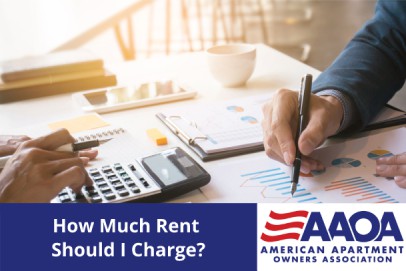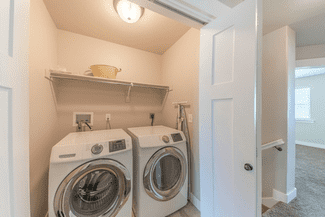How Much Rent Should I Charge?

As a landlord, the rental rate you choose will determine your long-term success in the real estate market. Set the rental price too high, and you could lose ideal tenants and get stuck with vacant properties. Set the rental price too low, and you’ll end up hurting your return on investment and losing profitability.
The key rent you should charge is competitively priced so as to attract your ideal tenants while still improving your bottom line. Here are four guidelines that can help you determine how much rent to charge your tenants:
Read on as we dive into these factors and important information to keep in mind as a landlord, whether you’re determining a month over month (MoM) or year over year (YoY) rent.
Determining a rental price for your property
A great place to start when figuring out how much to charge for rent is to determine how much your home or property is currently worth in today’s real estate market. This value will help you more accurately gauge your property’s worth, especially since it may be different from the price you originally paid for the property.
To discover how much your rental property is worth, landlords can either visit websites like Rentometer to make an estimate or find a home appraiser who will give a more accurate assessment. A home appraiser will determine their assessment based on the neighborhood, local sale prices, amenities and the property’s current conditions.
From here, there are different ways to set your official rent price.
Utilize the 1-2% rule
The 1-2% rule, originally known as the 1% rule, dictates that landlords should charge a monthly rent that is between 1 to 2% of the property’s total market value. For example, if a rental property is valued at $250,000, the landlord could charge between $2,500 and $5,000 per month.
While it may be tempting to charge on the higher end of the range, taking a look at local market rent prices may prove that the increased monthly rent amount is unattractive to a prospective tenant. If your rent is too high for the area, you’ll probably end up with a long-term vacant rental property. If your rent is too low, you may attract renters who are less than ideal.
Check out AAOA’s reliable tenant screening to make informed renting decisions on ideal renters.
The 1-2% rule range is a loose estimate rather than a hard rule — it shouldn’t substitute additional local property and rent research. Similarly, property prices may rise faster than rent prices, so they shouldn’t be the sole basis for your rental calculations.
Research comparable rental properties
Renters in your area will be looking at more than one property, so you should too. Get to know what a similar property (e.g., the same number of bedrooms and bathrooms, amenities, etc.) charges locally.
Your competitors will help you calculate a rent price that will attract tenants.
This baseline will also help landlords determine whether the home’s rent price will be affected by its neighborhood or other attractions nearby, such as stores or public transportation. Then the landlord can adjust their estimated base rental price accordingly.
Keeping an eye on the rental market can also help you keep track of any shifts in prices over time. This way, you can keep your monthly rent competitive and get the most out of your rental property.

Consider seasonality
As any landlord will tell you, rental market prices don’t stay stagnant over the course of a year — instead, they can fluctuate dramatically with the seasons as tenants enter and leave the market. However, these rent changes can be predicted.
Although renters move year-round, apartment searches usually begin to increase in January and then reach their peak in July. Most tenants don’t want to plan their move during the rainy, cold or holiday seasons, so summer is an ideal time for the moving season. Similarly, many renters are families or college students who usually move during summer break.
Additionally, most landlords offer 12-month leases, which create an easy-to-follow cycle of new and re-signed leases in June, July and August.
Considering these factors, landlords should be able to raise rental rates from April to June with even higher asking rates between July and August to match high demand. Rental price rates should then decrease in the fall through December.
Adjust rental prices based on property amenities
Beyond competitor and seasonal prices, it’s also important to consider what your property uniquely has to offer with amenities. If your property has additional amenities that can raise its rental value, they should be reflected in your listing and price.
For example, if two properties are in the same neighborhood with identical bedrooms and bathrooms, but one has an in-unit washer and dryer, that property can justify and charge higher rent.

Below are some in-unit and shareable amenities that can alter how much rent you charge:
- In-unit washer and dryer: As mentioned above, having an in-unit washer and dryer can significantly increase your property’s value to renters, especially if it’s located in a major city.
- Pool and/or outdoor space: Having additional yard space and/or a pool may be a huge bonus to renters with kids or pets.
- Parking: If your property is in a city, available parking can make a huge difference. Ensure you include if the property has a garage, assigned parking or street parking in the rental listing.
- Walkability: Oftentimes, rental prices reflect the location more than the actual property. Being close to schools, supermarkets, public transportation and more can set your property apart from other units for prospective tenants.
- Security: Overall safety can be a major concern for many renters. Offering additional protection through smart home technology, motion-activated property lights, security systems or personnel can increase how much you charge for rent.
Understanding rent control laws
Each state and city has its own rent control laws. As a landlord or property manager, it’s up to you to do your due diligence and research whether any of these laws will impact your rental prices. Mandated by the government for lower-income residents, rent control limits the amount that a landlord can charge for leases. Since each municipality has its own laws and regulations, landlords need to learn about their property’s specific area to ensure they aren’t breaking rent control laws.
For general state information for your rental property, you can check out the National Multifamily Housing Council’s rent control map as a helpful resource.
Why is it important to charge appropriate rent?
There are two main problems that can occur if a landlord charges too little or too much for rent:
- Your property attracts unfit renters.
- The rental property remains vacant.
Charging a competitive and fair amount of rent can help landlords attract the right types of prospective tenants to rent their properties. For example, these are renters with an ideal tenant credit check report and/or have a history of paying on time. Screening your tenants beforehand can help you avoid the worst-case future scenario: an eviction. Evictions are costly and time-consuming, so it’s best to prevent them from occurring.
An important way to gauge whether your rental price is the appropriate amount is to consider how much interest your property is receiving. If people aren’t applying or reaching out, it can be a clear sign that your rent is mispriced.
By choosing a monthly rent that isn’t too high or too low, landlords can maximize their profits and keep their units filled with the ideal tenants.
How much to charge for late rental payments
Calculating monthly rents shouldn’t be your only concern. Once you determine an appropriate amount, you’ll then have to figure out how much to charge for late rental payments. In theory, it’s best if all payments are on time, but that’s not realistic. Every now and then, you may have to charge your tenants a late charge.
Typically, a late rent charge is applied at least three to five days after the rent is due. Some landlords may choose to be flexible with this grace period guideline, depending on the tenant’s rental history or situation. Opting for this method can help improve the landlord-renter relationship, but it can also lead to unpredictable rent payments.
Your late charge can be applied in one of two ways:
- Daily fee: The landlord charges a predetermined fee for each day the rent is late. This amount is up to the landlord’s discretion, but an easy method is to charge $10/late day.
- Flat fee: The landlord charges a percentage of the monthly rent, regardless of how late it is. Typically, landlords choose to charge 5% of their monthly rent price. For example, if the monthly rent is $2,500, the late fee would be $75.
Important note: Ensure you research local laws and speak to an attorney regarding late rental payments and how you can charge for them. Landlords should always include their late rental fee amounts and rules within the lease. This information is a general explanation and is in no way meant to substitute for legal advice.
Get started with AAOA today
Looking for additional resources for landlords? AAOA offers industry-leading services and materials to help you make the most informed decision possible.















 Accessibility
Accessibility